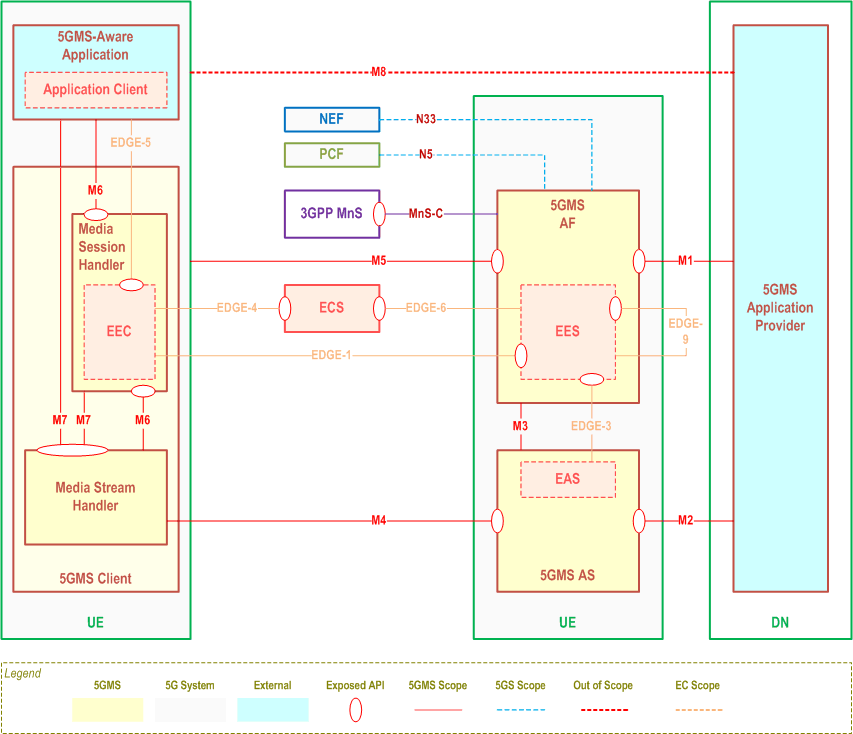Content for TS 26.501 Word version: 18.6.0
1…
4…
4.0.6…
4.1…
4.2…
4.2.2…
4.3…
4.4
4.5…
4.6…
4.7…
4.7.4…
4.8
4.9…
4.10…
5…
5.2…
5.2.4
5.2.5…
5.3…
5.3.2…
5.4…
5.5…
5.6…
5.7…
5.7.4…
5.7.8
5.8…
5.10…
5.10.5…
5.10.6…
5.11…
5.12…
5.12.4…
5.12.5…
6…
6.2…
6.2.2.2…
6.2.3…
6.3…
6.4…
6.8…
6.9…
6.9.5…
6.9.7
7…
8…
9…
A…
A.4…
A.8
A.9
A.10
A.11
A.12
A.13
A.14
A.15…
A.15.3…
B…
B.3
C…
C.3
C.4
C.5
D…
E…
4.5 5G Media Streaming architecture extensions for Edge Computing
4.5.1 Introduction
4.5.2 5G Media Streaming combined with Edge Computing
4.5.3 Provisioning and Service Information
4.5.4 Edge application context for 5GMS functions
4.5.4.1 5GMS AF context
4.5.4.2 5GMS AS context
...
...
4.5 5G Media Streaming architecture extensions for Edge Computing |R17| p. 43
4.5.1 Introduction p. 43
This clause defines an architecture that enables a 5GMS Application Provider to provision resources in the Edge DN for an application through the M1 interface by configuring an edge processing resource template.
Media processing in the edge may be achieved in one of two different ways at the application layer:
- Client-driven management: 5GMS-Aware Applications that are aware of the edge processing can directly request an edge resource and discover the EAS that is best suited to serve the application.
- AF-driven management: The 5GMS AF automatically allocates edge resources for new media streaming sessions on behalf of the application using information in the 5GMS Provisioning Session.
4.5.2 5G Media Streaming combined with Edge Computing p. 43
The 5GMS architecture is extended to add support for media processing in the edge. The extended architecture is an integration of the 5GMS architecture defined in the present document with the architecture for enabling Edge Applications defined in TS 23.558, and the Edge Computing management architecture defined in TS 28.538. The extended architecture is depicted in Figure 8.2-1.

Based on the extended architecture, the following assumptions shall apply:
-
A 5GMS AF that is edge-enabled shall support EES functionality including:
- EDGE-1 API for supporting registration and provisioning of EEC functions, and discovery by them of EAS instances.
- EDGE-3 API towards the EAS function of 5GMS AS instances.
- EDGE-6 API for registering with an ECS function.
- EDGE-9 API for media session relocation.
- A 5GMS AF that is edge-enabled shall be capable of determining (using information in the 5GMS Provisioning Session) whether a media streaming session meets the eligibility criteria for using edge resources.
- A 5GMS AF that is edge-enabled may perform compute resource allocation using the MnS-C interface.
- A 5GMS AS that is edge-enabled shall support EAS functionality including the EDGE-3 API for registration with the EES.
-
A Media Session Handler that is edge-enabled should support EEC functionality including:
- Invoking the EES function using the EDGE-1 API.
- Invoking the ECS function using the EDGE-4 API.
- EDGE-5 API exposed to the Application Client.
- A Media Session Handler that is edge-enabled shall be capable of determining (using 5GMS Service Access Information) whether a media streaming session meets the eligibility criteria for requesting edge resources.
- A 5GMS-Aware Application that is edge-enabled shall support Application Client functionality and should invoke the ECS function using the EDGE-5 API.
- In the client-driven approach, the 5GMS-Aware Application and/or the Media Session Handler cover and locate a suitable 5GMS AS instance in the Edge DN.is aware of the support of edge processing in the network and takes steps, such as using the EDGE-5 APIs, to discover and locate a suitable 5GMS AS instance in the Edge DN.
- In the AF-driven approach, the 5GMS Application Provider configures the 5GMS AF to automatically deploy edge processing for the media sessions of the corresponding Provisioning Session based on the provisioned edge processing resource template. The 5GMS-Aware Application may not be aware of the edge deployment and the EAS is discovered through other means, such as DNS resolution with support from the EASDF as specified in TS 23.548.
4.5.3 Provisioning and Service Information p. 44
The provisioning step allows a 5GMS Application Provider to configure information about its edge processing requirements for media streaming sessions.
The following information shall be configurable by the 5GMS Application Provider over reference point M1:
- Condition for activation of edge processing, e.g. the traffic descriptors, application identifier, geographic location of the UE, etc.
- Selection of client-driven or AF-driven management.
- EAS profile information for each EAS that will serve the application, such as the service KPIs, geographical location, and service continuity support. The EAS profile is defined in clause 8.2.4 of TS 23.558.
- Application context relocation tolerance and requirements.
4.5.4 Edge application context for 5GMS functions p. 45
4.5.4.1 5GMS AF context p. 45
The following application state may be subject to transfer during the application context relocation of an edge-deployed 5GMS AF instance:
- The EEC context maintained by the EES, as defined in clause 8.2.8 of TS 23.558.
- The session context maintained by the 5GMS AF, including the currently selected dynamic QoS and charging policy, any associated event subscriptions, the associated edge configuration, the consumption reporting configuration, QoE reporting configuration.
- Other internal context information such as traffic identification and steering information to support dynamic QoS and charging policies, history of network assistance and dynamic policy.
4.5.4.2 5GMS AS context p. 45
The following application state may be subject to transfer during the application context relocation of an edge-deployed 5GMS AS instance:
- The media stream context maintained by the 5GMS AS, which includes configuration for uplink streaming endpoint and any collected QoE reports.